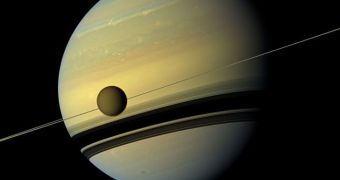This past July 2, researchers with NASA (the National Aeronautics and Space Administration in the United States) announced that the ocean inside Titan, i.e. Saturn's largest moon, could be about as salty as Earth's Dead Sea.
In a press release, NASA explains that this claim is based on information obtained with the help of the Cassini-Huygens spacecraft, which has been studying Saturn and its accompanying satellites since 2004.
Specifically, scientists say that, in order to try and pin down the makeup of the ocean inside Titan, they looked at data concerning the moon's gravity and topography. This helped draw conclusions concerning the ocean's density.
According to scientist Linda Spilker with NASA's Jet Propulsion Laboratory in Pasadena, California, and fellow researchers, gravity data provided by the Cassini-Huygens spacecraft indicates that Titan's inner ocean is surprisingly dense.
In fact, the specialists say that it is likely about as dense as our planet's Dead Sea is. This density is believed to be the result of a fairly high concentration of salts such as sulfur, sodium, and potassium that are dissolved in water.
“This is an extremely salty ocean by Earth standards. Knowing this may change the way we view this ocean as a possible abode for present-day life, but conditions might have been very different there in the past,” explains Giuseppe Mitri with the University of Nantes in France.
“Titan continues to prove itself as an endlessly fascinating world, and with our long-lived Cassini spacecraft, we're unlocking new mysteries as fast as we solve old ones,” Cassini project scientist Linda Spilker goes on to say.
The Cassini-Huygens spacecraft has also provided data indicating that the ice crust on Titan's surface varies in thickness. This indicates that oceans on this satellite are steadily crystallizing and turning to ice and that the moon's shell is rigid. If this were not the case, Titan's shape would have evened out long ago.
As explained by NASA researchers, the fact that Saturn's largest moon appears to be in the process of freezing solid is sure to influence material exchanges between the moon's surface and ocean, and, consequently, affect habitability.
Interestingly enough, previous studies provided evidence that Titan's atmosphere contains about 5% methane. Since the moon's surface is rigid, researchers are yet to figure out how it is that this methane reached its atmosphere.
“Our work suggests looking for signs of methane outgassing will be difficult with Cassini, and may require a future mission that can find localized methane sources,” Jonathan Lunine, a scientist on the Cassini mission at Cornell University, Ithaca, New York, says in a statement.

 14 DAY TRIAL //
14 DAY TRIAL //